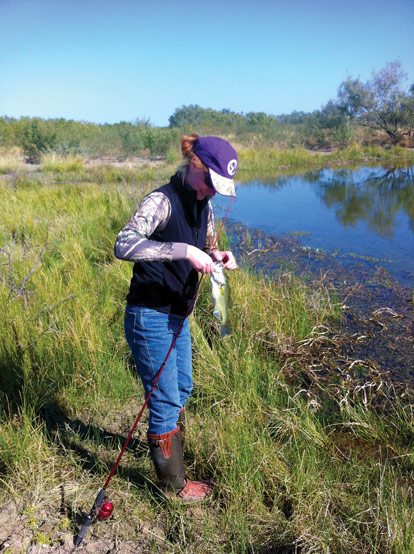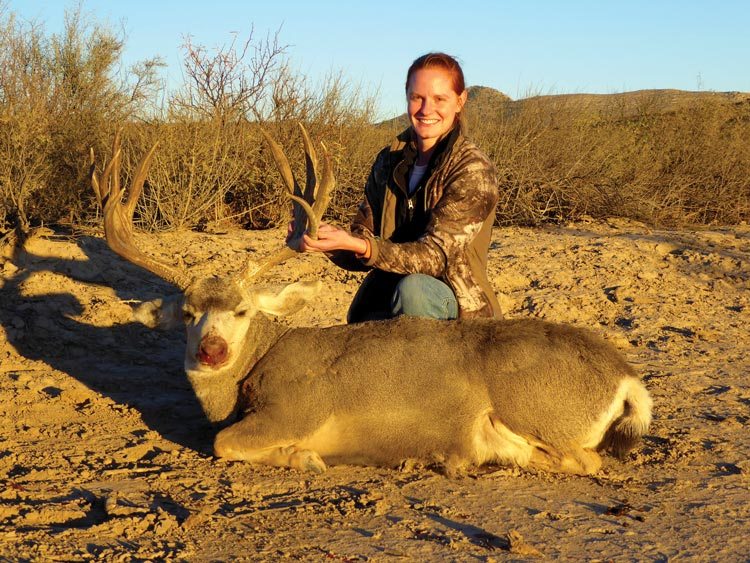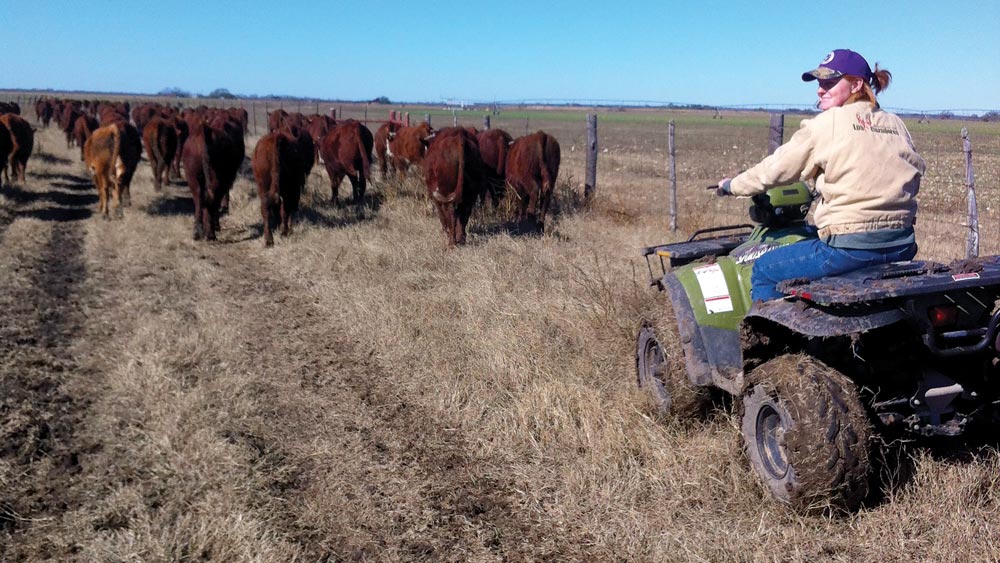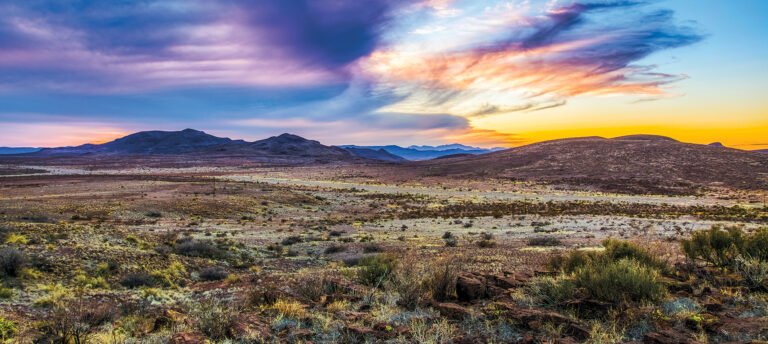By the time she was four, Sarah Nunley Biedenharn, who was reared near Sabinal, was driving a pickup on one of her family’s ranches operated under the Nunley Brothers’ brand. Of course, she was sitting on her father’s lap so she could see over the steering wheel and he could operate the pedals.
“There’s never been a time in my memory that ranching hasn’t been a part of my life,” said Biedenharn noting that whoever was driving didn’t have to open gates, a distinction that became important as she and her younger sister Caroline Nunley grew older. “Our family did everything together—and a lot of what we did revolved around the ranch, so the land is the foundation of who I am.”
Today, the newlywed and her husband, Tucker Biedenharn whose family ranches near Boerne, live and work in San Antonio. The couple gets out to one of the family’s properties as often as they can because the land and the lifestyle is a shared passion.
“I go on the weekends and help when I can,” Biedenharn said. “I’d love to be there full-time.”
 Headquartered near Sabinal, the Nunley Brothers’ ranch lands extend from South Texas up to the Hill Country and out to the Trans Pecos near Alpine and north to South Plains in the proximity of Lubbock. The family, led by her uncle, Bob Nunley, and her father, Richard Nunley, run an immense Santa Gertrudis cow-calf operation. The two brothers have been working side by side since they graduated from college in the 80s. The operation was founded by Biedenharn’s great grandfather, Red Nunley, who partnered with Dolph Briscoe Jr. to start his herd.
Headquartered near Sabinal, the Nunley Brothers’ ranch lands extend from South Texas up to the Hill Country and out to the Trans Pecos near Alpine and north to South Plains in the proximity of Lubbock. The family, led by her uncle, Bob Nunley, and her father, Richard Nunley, run an immense Santa Gertrudis cow-calf operation. The two brothers have been working side by side since they graduated from college in the 80s. The operation was founded by Biedenharn’s great grandfather, Red Nunley, who partnered with Dolph Briscoe Jr. to start his herd.
Today, one of the ranch’s primary focuses is breeding highly sought after replacement heifers. They are marketed at an annual sale each September hosted by Superior Video Auctions. In the run-up to the sale, the entire family is busy with workings across the state as well as shooting video.
“My sister, my cousin Chloe Nunley Wilson, and I are the fourth generation of our ranching family,” Biedenharn said. “We grew up watching our Dad and Uncle Bob work. We understand how much hard work it takes to make a ranch succeed.”
While the ranches were central to the family’s life, her parents, Richard and Kim, never pressured their daughters to follow in their footsteps.
“My parents always encouraged us to major in whatever field interested us and to go to work for other people for a while,” Biedenharn said.
The girls, who were homeschooled from the sixth grade through high school to give them the flexibility to spend time on the ranches, both went to TCU. Biedenharn pursued a double major in finance and accounting. Upon graduation in 2014, she spent two years in Dallas working with Goldman Sachs in its real estate investment division.
When she and Tucker got engaged, he was working in Wyoming. Because they both wanted to be closer to home, so she went back to the ranch and worked with her father and her uncle full-time for a year. After the couple married in April 2017, Biedenharn moved to San Antonio, where Tucker had accepted a job. She works for LiftFund, a non-profit that provides micro loans for small businesses.
“I’ve got one foot on the concrete and the other on the land,” she said. “I think it gives me a unique perspective on emerging issues that affect landowners, agriculture and conservation.”
A different perspective
Because of the physical demands of ranch work, the field has long had a reputation for being a man’s world. Biedenharn and her sister don’t see it that way. As they were growing up, their father focused on developing their skills but never ignored their gender.
“In the course of our hands-on education, he made us understand that we were different but not lesser,” Biedenharn said. “He taught us that intelligence and knowledge trump physical strength, but he made it equally clear that we have to understand how all of the ranch work is accomplished.
“In order to lead a business, you have to be able to teach someone else how you want things done, and as long as you understand how a task is accomplished you can ask for help.”
In order to lead a business, you have to be able to teach someone else how you want things done, and as long as you understand how a task is accomplished you can ask for help.
By acknowledging that ranch work is hard physical labor and giving the girls implicit permission to ask for help when tasks may require more strength than they had or put them in undue risk, he also gave them the freedom to succeed in the business on their own terms.
“I can’t speak for my sister or my cousin, but I think I have a unique view on feminism,” Biedenharn said. “I don’t have to be a man or act like a man to succeed in an industry that is still very male. I was never told that I couldn’t do something, but I was encouraged to do it differently to make the most of my strengths.”
These childhood lessons influence the dynamic at the daily morning ranch meetings where the day’s agenda is set, tasks assigned, business planned and decisions made. It’s been a long-time ritual for the brothers, who are now joined every day by Wilson, who is involved full-time. Biedenharn and Caroline, who works for a digital marketing firm in Fort Worth, participate when they are home.
“Dad and Uncle Bob tackle an issue from a male perspective, but then we women add our points of view—and the dynamic shifts,” Biedenharn said. “We see things differently. By embracing those differences, we, as a group, may come to an unexpected conclusion that is actually better than if any of us had gone it alone.”
The next generation of ranch leadership will be entirely female. Biedenharn and Caroline were gifted with a “classroom” ranch when they were in high school. It is theirs to manage. Because they are both working away from the ranch currently, Richard is the consistent physical presence, but they are the sole decision makers.
“We get to learn about everything on a smaller scale,” Biedenharn said.
One of the many lessons that Biedenharn has learned is the value of technology in what many perceive as a hidebound industry. One industry-changing example is RFID (radio frequency identification system) tags. The tags implanted soon after a calf is born allow the family to gather and record production information as well as trace the whereabouts of that animal through the entire production chain. The family members adopted the technology early on and it is impacting the way they do business.
“The general public has no idea how technology is changing our business,” Biedenharn said. “It is making us much more efficient—and illuminating other efficiencies that can be gained.”
The general public has no idea how technology is changing our business. It is making us much more efficient—and illuminating other efficiencies that can be gained.
As a next generation rancher, she is clear-eyed about the future. Rising land prices that prompt sub-division of large tracts will make it more difficult for the sprawling ranches that shaped the culture of Texas to exist.
“I think the law of supply and demand is going to sort it out,” Biedenharn said.
Those large ranches that remain will not be the ranches of lore that were the sole domain of hard-riding, whooping and shooting cowboys on horseback.
“The romantic notion of ranching is just that—a romantic notion,” Biedenharn said. “People tend to forget that we ranchers are in the business of raising beef to feed people. I don’t think people are going to quit eating beef, so I think the ranching industry is here to stay. It may look different, but it will be here.”

A favorite memory
“That’s a hard question because I loved growing up on the land. The first answer that comes to my mind is driving with Dad. We were always going to check on something or headed to a working somewhere—and that generally involved traveling a distance. When we’d be pretty far along into our seven or eight hour trips, we’d always find a convenience store and buy some of those weird triangle sandwiches and snacks. Through the whole trip, we just talked and talked. We solved the world’s problems and spent hours imagining great inventions we could engineer. Those were just some of my favorite times because we were truly together.”
The best part of the day
From dawn to dark-thirty is the average work day on a ranch. The Nunley Brothers’ operation is no different. For Biedenharn, the morning is the best part of the day.
“Everybody meets at the kitchen in the men’s house. It has a coffee pot, a wood stove and a computer. We drink coffee. The hands get their orders for the day. Dad and Bob talk business with us chiming in.
“About the same time, the sun is rising and the animals wake up. We’re starting our day just as the world is starting its.
“Then we drive the ranch to see what has changed since the last time I was there . . . what roads have been worked on or washed out . . . whether the tanks are full or dropping. The sort of stuff that marks progress and prompts you to spot the next projects or prepare for what’s coming in terms of Mother Nature.
“After that, Dad runs errands in town and I go with him because in the process I get to see everybody. We generally go by the bank and the feedstore with a few other stops thrown in for variety.
“That’s our normal routine for a normal day. A lot of times, though, we’re on a mission to get supplies to fix something that has broken overnight. Come to think of it, that may be our real normal on
the ranch.”
TWA connection
Biedenharn is a lifelong hunter. She remembers beginning school and becoming her dad’s deer hunting companion about the same time. In her experience, hunting and conservation go hand-in-hand, but she recognizes that many people in the world don’t see it that way.
TWA’s commitment to hands-on conservation education drew her to the organization.
“I’ve always been passionate about conservation, so I found myself aligned with TWA’s commitment to youth conservation education. In my personal experience with friends who grew up hunting and those who didn’t, I came to understand that people who are not exposed to something such as hunting find it easy to dislike it or fear it. They hold onto a misperception or stereotype instead of opening themselves to the experience and the whole truth.
“Wildlife management and conservation is also part of the mix on our ranch. On some of our properties, we have lease hunters while on others it’s for our own personal enjoyment.
“In either case, hunting is a means of managing the population of animals so that you can take care of the habitat that supports not only the deer, but all of the other wildlife. It’s not about killing as so many people wrongly believe. In ranching, it’s about a striking a balance where you benefit the wildlife and the livestock.
“TWA, through a lot of different programs, works hard to make sure young Texans understand the role private landowners play in conserving the wildlife and open spaces that make Texas special.
“For me, I hope that my legacy is somehow helping children understand conservation and business. We have to have conservation that makes ecological and economic sense, so that we have healthy natural resources forever.”


